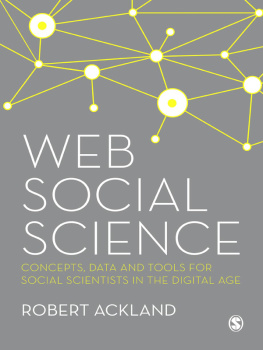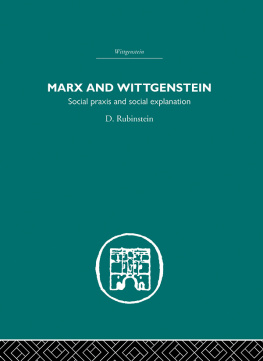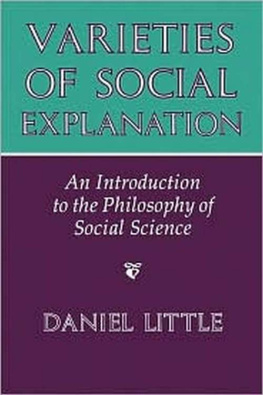EXPLANATION AND EXPERIENCE IN SOCIAL SCIENCE
EXPLANATION AND EXPERIENCE IN SOCIAL SCIENCE
ROBERT BROWN
First published 1963 by Transaction Publishers
Published 2017 by Routledge
2 Park Square, Milton Park, Abingdon, Oxon OX14 4RN
711 Third Avenue, New York, NY 10017, USA
Routledge is an imprint of the Taylor & Francis Group, an informa business
Copyright 1963 by Robert Brown.
All rights reserved. No part of this book may be reprinted or reproduced or utilised in any form or by any electronic, mechanical, or other means, now known or hereafter invented, including photocopying and recording, or in any information storage or retrieval system, without permission in writing from the publishers.
Notice:
Product or corporate names may be trademarks or registered trademarks, and are used only for identification and explanation without intent to infringe.
Library of Congress Catalog Number: 2008002923
Library of Congress Cataloging-in-Publication Data
Brown, Robert, 1920-
Explanation and experience in social science / Robert Brown.
p. cm.
Reprint. Originally published in 1963 as : Explanation in social science.
Includes bibliographical references and index.
ISBN 978-0-202-36234-2
1. Social sciencesMethodology. 2. Social sciencesResearch. I. Brown, Robert, 1920- Explanation in social science. II. Title.
H61.B68 2008
300.72dc22
2008002923
ISBN 13: 978-0202-36234-2 (pbk)
A POLOGETIG disclaimers are often written and seldom read. This is probably as it should be, since excuses addressed to the reader can benefit only their author. The obvious exception arises when, as in the present case, the author takes the opportunity to point out how quickly some important topics have been dismissed. Each reader may compile his own list from this essay, but at the head of my own list stands the logical features of scientific laws and theories. It is some consolation, of course, that the errors I might have fallen into will now be made by someone else. It is more useful, however, to remind the reader that there is now an extensive literature devoted to the philosophical problems raised by scientific laws and theories. Many of these are discussed, for example, in Ernest Nagels The Structure of Science, a book which arrived too late to save me from mistakes that I might otherwise have learned to avoid.
The labour of reading the first draft of this book was undertaken by Mr D. M. Armstrong; drawing his attention to it once again is poor recompense, I am afraid, for his help and advice. Professor P. H. Partridge read an early version of some chapters, and I am grateful for his comments on them. I am deeply indebted to Professor J. C. Harsanyi for much criticism, for the wording of certain passages, and for several examples. Mr F. H. G. Gruens reading of two chapters brought out their weaknesses, but in thanking him I cannot claim to have fully met his criticism. Professor I. F. Pearce and Drs F. Stacey and E. K. Inall have generously supplied me with examples. I recall the time and effort they have spent on my education with gratitude. But above all, I should like to thank Professor John Passmore. It is on his resources that I have drawn most heavily, and I have done so with no acknowledgement other than this.
For permission to quote I thank the following: from an article by D. Braybrooke in American Political Science Review, the Executive Director, The American Political Science Association; from an article by N. R. Hanson in The Philosophical Review, the author, and the managing editor; from an article by P. C. Dodwell in Mind, the author, and the editor; from an article in Africa, the Director of the International African Institute; from an article of mine in Philosophical Studies, the editor; from her book Studies in Applied Anthropology, the author, L. P. Mair; from his book The Great Crash, 1929, the author, J. K. Galbraith; from Street Corner Society by W. Whyte, the publisher, the University of Chicago Press, copyright 1943 by the University of Chicago; from G. Homans and D. Schneider: Marriage, Authority and Final Causes, the publisher, The Free Press; from Risk, Uncertainty and Profit by F. Knight, the holders of the copyright, Hart, Schaffner and Marx; from E. E. Evans-Pritchard: Witchcraft, Oracles and Magic Among the Azande the author, and the publisher, The Clarendon Press; from E. Krige and J. Krige: The Realm of a Rain Queen, the co-author, E. Krige: from J. Barnes: Politics in a Changing Society, the author, and the Director of the Rhodes-Livingstone Institute; from his book Wildcat Strike, the author, A. W. Gouldner.
I thank Mrs. F. Dadd for reading the proofs of this book.
Contents
PART ONE
DESCRIPTION, OBSERVATION AND EXPLANATION
PART TWO
METHODS OF EXPLANATION
T HERE is a sense in which the question What is this book about? is best answered by an examination of the volumes table of contents. What is not given in the list of chapter headings, however, is an indication why some topics are listed there and why others with an apparently equal claim to recognition are not. The present study has as its aim the discussion of certain questions of philosophical interest as they come to be imbedded in the work of social scientists. It is intended to be an essay which might be of interest to the practising scientist. For most studies in the philosophy of the sciences, natural and social, fall into two distinct groups: those written by philosophers for other philosophers and those produced by scientists for their fellow-scientists. And since many writers on these subjects at least imagine that they have a catholic audience, it is a constant disappointment on both sides that the works submitted are usually unsuccessful in this respect. Yet the reasons for this are obvious.
Consider the case of a demographer who is investigating the social origins of recent immigrants to Australia. He may wish to predict how rapidly the various national groups will be assimilated. If, on the basis of the social adjustment of a sample population, he makes predictions about the behaviour of a future population his inference may be challenged. It may be said that he is merely assuming that the future will be like the past; he is mistaking trends which depend on temporary and obscure conditions for laws based upon known factors. In short, he is misusing a description as an explanation. Now he may be disturbed enough by this criticism to become interested in the general question how social description differs from social explanation. But if he does so he will not receive much help from the writings of social scientists. Their writings tend to consist, on the one hand, of instruction in research techniques, and on the other, of some remarks on induction as viewed by John Stuart Mill. There are, of course, studies which fall into neither of these two categories. Robbins Essay on the Nature and Significance of Economic Theory and Nadels The Foundations of Social Anthropology are familiar examples. They would give little aid to anyone interested in the demographers question, however. The first does not deal with it, and the second deals only with such related questions as the connection between facts and theory or between observation and interpretation. Thus the demographer might well turn to the writings of philosophers for assistance. There he would find a rich literature on problems of the physical sciences and psychology. In contrast, the literature concerned with social science would, if confined to modern work, hardly fill a small shelf. Kaufmanns







